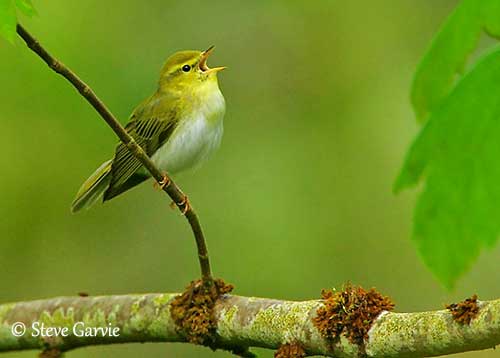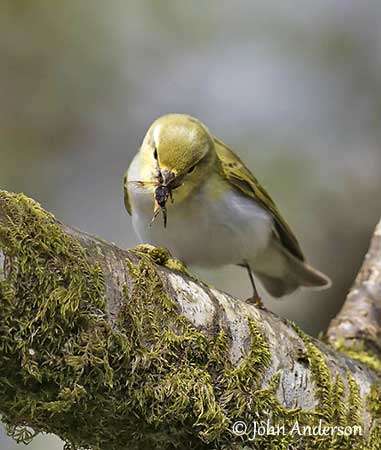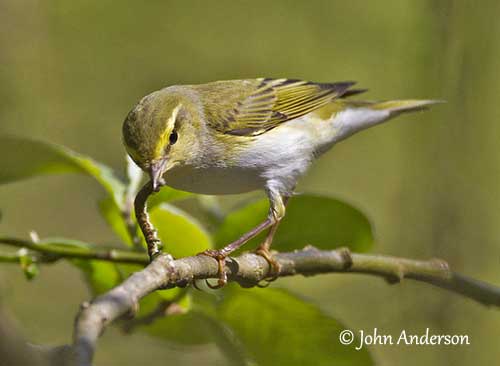
Fr: Pouillot siffleur
Ang: Wood Warbler
All: Waldlaubsänger
Esp: Mosquitero Silbador
Ita: Luì verde
Nd: Fluiter
Sd: grönsångare
Photographers:
John Anderson
John Anderson Photo Galleries
Steve Garvie
RAINBIRDER Photo galleries & Flickr Rainbirder
Otto Plantema
Trips around the world
Text by Nicole Bouglouan
Sources:
HANDBOOK OF THE BIRDS OF THE WORLD Vol 11 by Josep del Hoyo, Andrew Elliott and David Christie - Lynx Edicions - ISBN: 849655306X
The Cornell Lab of Ornithology - Birds of the World
How resilient are Wood Warblers to forest loss on the wintering grounds?
Northern Ireland Priority Species
British Birds - On the Song of the Wood-Warbler
What Bird-The ultimate Bird Guide (Mitchell Waite)
Wikipedia, the free encyclopaedia
Wood Warbler
Phylloscopus sibilatrix
Passeriformes Order – Phylloscopidae Family
INTRODUCTION:
The Wood Warbler is relatively common and widespread throughout its large range. It breeds in N and temperate European regions and in the southern Ural Mountains. The species is migratory and moves to tropical Africa after breeding.
It frequents the forest with various tall tree species, and also breeds in conifer forests. It feeds mainly on invertebrates, but it also consumes fruit, according to the season.
The nest is built on the ground by the female, a dome-shaped structure placed in low bush or under fallen tree or among roots. Both parents feed and rear the young.
The Wood Warbler is known for its song, actually including two song types, a high-pitched, metallic trill of increasing tempo, and a series of some descending lower piping notes.
The Wood Warbler is locally affected by changes in forestry management involving some declines. But currently, the species is not globally threatened.

DESCRIPTION OF THE BIRD:
Biometrics:
Length: 11-13 cm
Wingspan: 21-23 cm
Weight: 6,5-15 g
The Wood Warbler has uniformly grey-olive upperparts, becoming slightly greyer in worn plumage. On the upperwings, the edges of both median and greater coverts and the edges of the flight-feathers are yellowish-green, whereas the inner webs are dark brown. Tertials have yellowish-white fringes. The pale edges may sometimes form a panel, more visible on closed wings. The wings are long and pointed. The tail is relatively short, with yellowish-green edges to outer rectrices.

On the underparts, chin and throat to upper breast are bright yellow, whereas rest of underparts is white.
Some individuals may have brown upperparts and lack the yellow on face and throat.
On the head, forehead, crown and nape are grey-olive like the upperparts. We can see a well-defined, long, pale yellow supercilium that reaches the ear-coverts. A narrow, dark olive-green eyestripe contrasts with the pale supercilium. Cheeks and ear-coverts are bright yellow.

The thin, pointed bill has brown to pale brown upper mandible, and yellowish-pink lower mandible. The eyes are dark brown. Legs and feet are brown to yellowish-brown.
Male and female are similar.
The juvenile is usually duller with grey wash on the upperparts and less yellow on throat and breast.
RANGE:
The Wood Warbler breeds in northern Europe and temperate European regions. It breeds from W Norway, British Islands and W and C France, E to SC Siberia and S through Italy, extreme N Greece, NW Turkey and SW and C Ukraine.
Some populations also breed in Crimea and NW Caucasus, rarely in NE Kazakhstan.
It spends the winter in Africa, from Sierra Leone and S Guinea, E to S South Sudan, N DR Congo, Uganda, Rwanda, Kenya and S Somalia.

HABITAT:
The Wood Warbler frequents open, shady, mature deciduous woodlands, especially beech (Fagus), mixed oak (Quercus), and also Carpinus and Castanea tree species, mainly with closed canopy and sparse undergrowth. It also frequents coniferous forests with mixed tree species.
During winter in Africa, it frequents humid evergreen forests and wet thickets, but also dry woodland and forested slopes, and a variety of wooded habitats.
CALLS AND SONGS: SOUNDS BY XENO-CANTO
The Wood Warbler has two distinct songs with no resemblance to each other, and they are very rarely mixed.
The first is the usual song, a series of rising and accelerating “sip” followed by fast, descending, melodious trill described as “sip sip sip sirrrrrrrrrrrrr”. While singing, the bird’s wings and tail are shivering.

Wings and tail are shivering,
clearly visible here.
The second song often varies according to each individual, with different number of syllables, but the tone is constant. This song is sweet and plaintive in tone, and falls gradually. It includes soft, clear piping “pew” or “tiu” notes, given separately or between trills.
In aggression, the bird gives a single-note “pew”. But other notes including “tee” and “tiu” together with sharp “pit” or “sip” notes are also given by aggressive birds.

BEHAVIOUR IN THE WILD:
The Wood Warbler feeds on various invertebrates, and especially insects and spiders. Some fruits are also part of the diet according to the season.
Insects include mayflies, damselflies, bugs, larval and adult moths, flies, ants, larval and adult beetles. It also consumes spiders and small molluscs.
Fruits include bramble, elder, bilberry, Prunus and Frangula species.
Insects are caught in acrobatic flycatcher-like sallies and hovering. The bird forages in both canopy and undergrowth of forests. It forages alone or in pairs, but it may join mixed-species foraging flocks outside breeding season.

The Wood Warbler male performs beautiful song-flight to attract a female at the beginning of the breeding season. As this species lives in woodlands, there is no space to make aerobatics. However, the male follows a horizontal course between different perches, flying fast with shallow wingbeats.
This flight is performed over any female that enters the male’s territory. She utters a soft contact call and the male approaches while flying slowly, before to chase her. During courtship while both are perched close to each other, crown and nape feathers are raised while the male bows repeatedly. The breast feathers are puffed out, the wings are shivering and the tail is fanned.

The Wood Warbler is monogamous, but often also polygamous, and the male may have two mates, involving some unpaired competitors. This tends to occur when the first female is incubating, leaving her partner free during several days.
The male may solicit for another female, sometimes at the edge of its territory or a different area. It will help the first or the second female for raising the chicks, but it may also divide its attention and share the nesting duties of both broods.
The territory is established by the male, and both mates defend it.

The Wood Warbler is migratory. It moves southwards to reach sub-Saharan Africa where it spends the winter. The European population leaves the breeding grounds from mid-July but mainly in August, and slightly later, from mid-September, in E Europe.
They arrive in late August/early September and October, depending on the location. The return passage starts in March, but mainly April/mid-May. They arrive in W and C Europe in the second half of April/early May.
The males arrive first and establish the territory, usually one week before the females.
The Wood Warbler is very agile in flight, especially during the flight displays.
During the usual flight, the bird alternates several rapid wingbeats with short glides.

REPRODUCTION OF THIS SPECIES:
The breeding season takes place between May and July. This species usually produces a single brood, but sometimes two in C France.
The territory is established by the male, but the female selects the nest-site. She builds the nest, a domed structure placed on the ground, usually under fallen tree or among roots, often on a slope. It is built close to a low bush that provides useful perch to feed the chicks.
Nest materials are collected in the surrounding, within ten metres from the chosen site. The nest is made with dry grasses, leaves, stems, vegetal fibres, bark strips and animal hair.

The female lays 5-7 white eggs heavily spotted grey-brown over the surface. She incubates alone during 12-14 days. The chicks are raised by both parents.
They are mainly fed with caterpillars and other larvae, and later with increasing amounts of adult flies. The young fledge 11-13 days after hatching. Both adults feed them for 2-3 days after leaving the nest. They remain in family group for up to one month.
Nest predation by Eurasian Buzzard, Eurasian Jay, Eurasian Sparrowhawk and various mammals and small rodents may involve up to 75-80% of nest losses.

PROTECTION / THREATS / STATUS:
The Wood Warbler is locally common and widespread throughout the large range.
The species is affected by land-use change and loss of natural habitats, and forest loss in the wintering grounds in sub-Saharan Africa.
The European breeding population is roughly estimated to number 14,100,000/22,100,000 mature individuals (2015). Europe forms 80% of the global range, and a very preliminary estimate of the global population size is 17,600,000/27,600,000 mature individuals. But more information is needed.
The European population is slowly declining.
But the species is not yet globally threatened and the Wood Warbler is currently evaluated as Least Concern.
